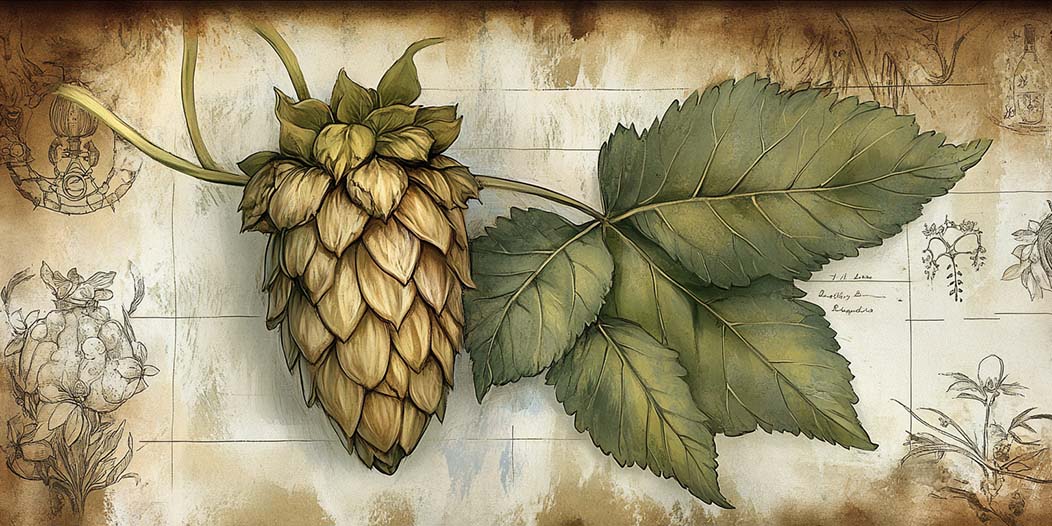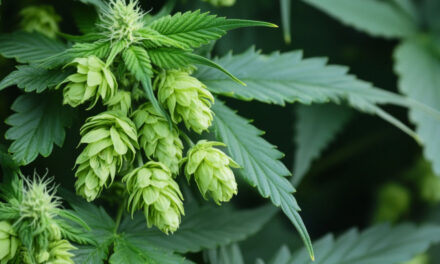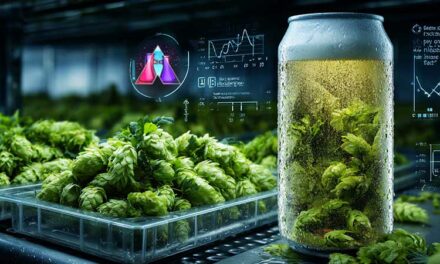From Bittering Agents to Bioactive Marvels
1. Introduction: The Hidden Complexity of Hops
Hops (Humulus lupulus L.) have been central to beer brewing for centuries, providing not just bitterness and aroma but also acting as natural preservatives. However, recent scientific investigations have revealed that hops are much more than a brewing ingredient—they are a reservoir of bioactive compounds with diverse applications in health, cosmetics, and pharmaceuticals.
This article explores the chemistry, sensory contributions, health benefits, and terroir influences of hops, revealing how this versatile plant shapes not only our beer but potentially our health and industries beyond brewing.
2. The Chemistry of Hops: Unpacking Lupulin Glands
The essential brewing value of hops resides in their lupulin glands, located in the cones of the female hop plant. These glands produce a cocktail of bioactive compounds, including resins, essential oils, and polyphenols.
2.1 Alpha and Beta Acids: The Foundation of Bitterness
- Alpha Acids (Humulones): These compounds are responsible for beer’s bitterness when they are isomerised during boiling. They also possess antimicrobial properties, preventing spoilage by unwanted microorganisms.
- Beta Acids (Lupulones): While less soluble in beer, beta acids contribute to beer’s stability and have potential anticancer and antibacterial effects.
- Iso-α-acids: These are the isomerised forms of humulones, providing the characteristic bitterness in beer and exhibiting strong antibacterial effects against Gram-positive bacteria.
2.2 Essential Oils: The Aromatic Signature
Essential oils are a mix of volatile compounds contributing to the beer’s aroma and flavor. They can be divided into:
- Monoterpenes and Sesquiterpenes: Provide herbal, woody, and spicy notes.
- Oxygenated Terpenes: Such as linalool and geraniol, responsible for floral and citrus aromas.
- Sulfur-containing Compounds: Play a role in unique, pungent hop aromas but require careful control due to their low sensory threshold.
2.3 Polyphenols: The Unsung Heroes
- Flavonoids: Such as xanthohumol and catechin, have potent antioxidant and anticancer properties.
- Tannins: Contribute to beer’s mouthfeel and astringency.
- Xanthohumol: A major polyphenol with anticancer, anti-inflammatory, and antioxidant activities.
3. Hops and Beer Quality: More Than Bitterness
Hops influence beer in multifaceted ways beyond simple bitterness:
3.1 Bitterness and Foam Stability
- Alpha acids ensure consistent bitterness through isomerisation during boiling.
- Hop resins stabilise beer foam by interacting with proteins in the beer matrix.
- Beta acids contribute long-lasting bitterness, particularly in aged beers.
3.2 Aromatic Complexity
The sensory profile of hops varies based on:
- Hop Variety: Different varieties offer distinct aroma profiles (e.g., Cascade for citrus, Saaz for earthy tones).
- Essential Oil Content: Linalool and geraniol are key aromatic drivers.
- Timing of Hop Addition: Kettle, whirlpool, or dry hopping each emphasizes different aroma compounds.
3.3 Mouthfeel and Astringency
- Hop polyphenols contribute to a dry, astringent finish in certain beer styles.
- Interactions with carbonation and ethanol create a balanced mouthfeel.
4. Bioactive Potential of Hops: From Beer to Health Applications
Hops are increasingly recognized for their medicinal properties, opening doors for their use in pharmaceuticals and functional foods:
4.1 Antioxidant Properties
Polyphenols in hops neutralize free radicals, reducing cellular damage and oxidative stress.
4.2 Antimicrobial Activity
- Bitter acids (α- and β-acids) inhibit Gram-positive bacteria, contributing to beer’s long shelf life.
- Potential applications as natural preservatives in the food industry are being explored.
4.3 Anticancer Potential
- Xanthohumol: Inhibits cancer cell proliferation, particularly in breast and colon cancers.
- Hexahydro-β-acids: Trigger apoptotic pathways in certain cancer cells.
4.4 Sedative and Sleep-Inducing Effects
- Hop extracts have traditionally been used for their sedative properties, aiding in sleep disorders.
- Synergies with other calming herbs, such as valerian root, are being studied.
5. Sensory Science of Hops: The Multisensory Experience
Beer drinking engages multiple sensory pathways, and hops play a significant role:
5.1 Synergistic Aromas
- Linalool and geraniol exhibit synergistic effects, enhancing fruity and floral aromas.
- Cross-modal effects between hop bitterness and aroma influence overall beer flavor.
5.2 Trigeminal Sensations
- Sesquiterpenes may activate trigeminal receptors, producing tingling or warming sensations.
- Carbonation enhances these effects, adding depth to beer’s mouthfeel.
5.3 Beer Matrix Effects
- The composition of beer (alcohol, carbonation, residual sugars) modulates the release and perception of hop volatiles.
6. Terroir: The Influence of Place on Hop Character
Terroir—a concept borrowed from wine—plays a pivotal role in hop chemistry and beer flavor:
- Geographical Differences: Cascade hops grown in Germany produce different aromatic profiles compared to U.S.-grown Cascade.
- Environmental Factors: Soil composition, water availability, and sunlight hours impact alpha acid content and essential oil profiles.
- Regional Signatures: Brewers can now emphasize hop terroir in single-hop beers, offering a unique sense of place in each sip.
7. Brewing Techniques and Hop Utilisation
Different brewing techniques extract hop compounds in unique ways:
- Kettle Hopping: Maximises bitterness through isomerisation of alpha acids
- Late Hopping: Preserves delicate aromatic compounds with less heat exposure
- Dry Hopping: Enhances volatile aromas without isomerising alpha acids
8. Future Directions in Hop Research
- Advanced Extraction Techniques: For isolating bioactive compounds efficiently.
- Hop Breeding Programs: Developing disease-resistant, aromatic varieties.
- Non-Brewing Applications: Exploring hop compounds in skincare, dietary supplements, and pharmaceuticals.
9. Conclusion
Hops are not just a brewer’s ingredient—they are a treasure trove of chemical diversity with applications spanning food science, medicine, and cosmetics. As research continues to evolve, the humble hop cone might just be the key to innovations in health, flavor science, and sustainable brewing.
Sources:
Chemical constituents and bioactivities of hops (Humulus lupulus L.) and their effects on beer-related microorganisms, 2020, Cong Nie, Haojun Zhang, [10.1002/fes3.367]
Humulus lupulus – a story that begs to be told. A review, 2014, Martina Gastl, [10.1002/jib.160]
The multisensory perception of hop essential oil: a review, 2020, Rebecca Ford, [10.1002/jib.622]
Relevance of hop terroir for beer flavour, 2021, Ann Van Holle [10.1002/jib.648]










Recent Comments